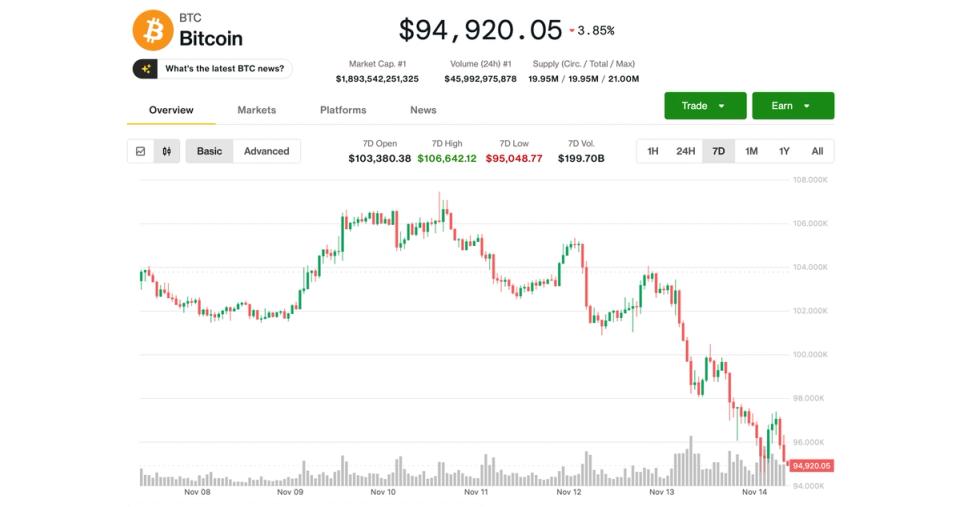Bitcoin saw no rebound on Friday, holding at a session low below $95,000 late in the day in the United States, after a bruising week that sent prices to their lowest level since May.
The largest cryptocurrency is once again underperforming U.S. stocks, with major U.S. indexes holding on to minor gains minutes before trading ended. BTC was on pace to record a 9% loss for the week, its performance in eight months.
Ethereum trading below $3,200, has fared worse, falling more than 11% since Monday, while Solana’s SOL lost 15% over the same period. It held up better, down just 1%, perhaps buoyed by the launch this week of its first U.S. cash ETF, issued by Canary Capital.
Crypto-related stocks saw mixed performance after Thursday’s sharp losses. MicroStrategy (MSTR), the largest public holder of Bitcoin, slipped another 4% below $200 for the first time since October 2024. Exchange Bullish (BLSH), Ethereum Treasury BitMine (BMNR), miners CleanSpark (CLSK), MARA Holdings (MARA), and Hive Digital (HIVE) slipped 4-7%.
On the positive side, miner Hut 8 rallied 6% following results from American Bitcoin, a joint venture with the Trump family, while digital brokerage Robinhood (HOOD) and BTC miner Riot Platforms (RIOT) rose about 3%.
“Information vacuum” clouds investor confidence
The current market slowdown is largely due to the lack of clarity on key US economic conditions and the further direction of monetary policy, Bitfinex analysts said. The data outage was due to the longest U.S. government shutdown, which lasted from Oct. 1 through Thursday, and suspended the release of government data on inflation and employment.
“The market retracement is the result of an information vacuum and policy uncertainty,” they wrote in a note shared Friday with CoinDesk. “There is still a lack of key economic data to guide the market and the Federal Reserve, putting investors on hold.
However, the spending bill ending the shutdown that lawmakers passed only provides funds to keep the government open through Jan. 30, weighing on investor confidence. “The temporary funding bill does not resolve the uncertainty, it only pushes the problem further.” Bitfinex analysts added.
Noelle Acheson, author of Crypto Is Macro Now, said the recent pullback was a necessary correction after months of limited consolidation that failed to sustain a breakout above $120,000. “We need to get over these hot flashes before we can breathe easier,” she wrote. “Once that happens, the long-term case for BTC gets stronger – but we’re not there yet.”
The main driver of BTC remains macroliquidity, Acheson added. Although a further Fed rate cut may not come until the end of the first quarter of 2026, expectations of balance sheet adjustments or other easing measures and “liquidity injections” could help restore optimism around risk assets, including BTC, she said.
BTC heading towards $84,000, says Ledn CIO
Meanwhile, technical indicators suggest Bitcoin could still have plenty of room to decline, said John Glover, chief investment officer at crypto lending firm Ledn.
He noted that a break below the 23.6% Fibonacci retracement level, just below $100,000, opened the way to the next key support level, located at around $84,000.
Glover believes the current pullback is part of the Bitcoin bear market, predicting volatile action for the months to come. “We will likely see prices return above $100,000 before any sustained break below $90,000,” he said, noting that the full correction could play out until summer 2026.




